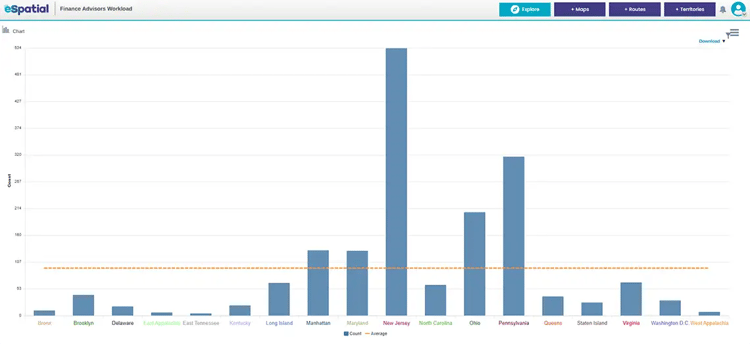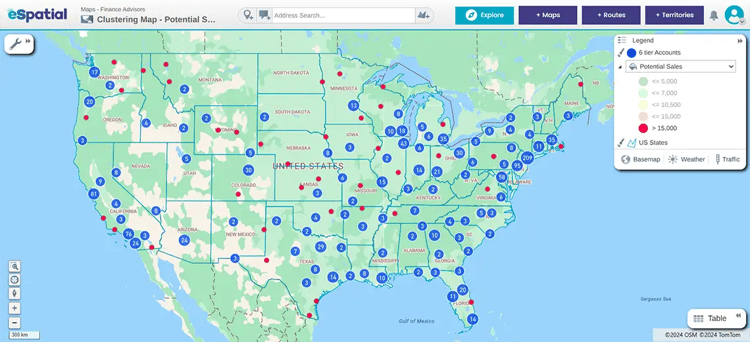Financial advisors juggle many administrative duties in a high-pressure environment. The work can get overwhelming, and they may experience burnout, leading to less motivation, poor interactions, and decreased customer satisfaction.
Equal workload distribution helps advisors stay on course and focus on client relationships. But how can you ensure distribution is truly equitable? With mapping software.
Our solution enables visualization of geographical data to understand the distribution of advisors in an area. eSpatial mapping software has powerful features that allow for quick adjustments in territory alignment, ensuring equal distribution of workload among team members.
Challenges of Unequal Distribution of Workload
When one person carries too much of the workload, they also carry too much stress. Unequal distribution of work hurts employees and clients and affects a company's ROI. Overworked employees are unproductive, while underutilized ones don't make enough profits.
At the end of the day, both overworked and underworked team members will look for greener pastures. Given the high turnover rate of financial advisors, understanding and addressing the causes and consequences of unequal workload distribution helps retain your team and boost your bottom line.
Common Causes of Unequal Workload Distribution
Imbalances in workload distribution can stem from a variety of organizational and individual factors. Identifying these causes is essential to creating a more balanced and productive workplace. Below are some of the key contributors to this issue.
- Geographic client clustering: When clients are clustered geographically, advisors in those areas have more clients than their counterparts in less populated regions. This results in some advisors being overwhelmed with client demands while others have a lighter load.

- Advisor skill specialization: Advisors specialize in specific skills such as retirement planning, tax strategy or investment management. A higher demand for one type of expertise can create an imbalance in workload. Advisors with highly sought-after skills may find themselves burdened with tasks, while others may have fewer clients or less complex cases, leading to disparities in workload.
- Reactive client allocation strategies: Assigning financial advisors to clients based on needs or requests can cause unequal workload distribution, as they naturally respond to immediate client needs rather than plan for equitable task distribution. Without proper client allocation, advisors may inadvertently focus on existing clients at the expense of new client acquisition, further exacerbating the imbalance.
- Lack of clear role definitions: Without clearly defined roles and responsibilities, advisors may take on tasks that should belong to others, overloading some team members while others have little to do. This ambiguity can cause frustration and resentment among team members.
- Failure to utilize project management tools: Failure to employ project management tools can hinder the ability to track workloads effectively. Identifying and addressing imbalances becomes easier with visibility into each advisor's capacity and task allocation.
- Overreliance on high performers: Managers often lean heavily on top performers to handle more tasks due to their reliability and proven track record. This tendency can lead to these individuals being overburdened while others need to be more utilized, creating an imbalance in workload distribution.
Addressing these causes requires management strategies that include regular workload assessments and equitable task allocation based on skills and availability.
Unequal Workload Distribution Consequences
Unequal workload distribution can have far-reaching effects on employees and organizations, impacting everything from team dynamics to overall performance. Below are some of the most common outcomes of this challenge.

- Overworking leads to burnout: Employees overloaded with tasks are at a higher risk of experiencing burnout, which can lead to physical and mental exhaustion. Burnout affects individual well-being and increases the likelihood of employees seeking new jobs.
- Uneven client satisfaction: Advisors overloaded with tasks and high-maintenance clients may struggle to provide timely responses and personalized service, resulting in frustrated clients who feel neglected. Clients of overburdened advisors experience delays and reduced support, while those of underutilized advisors don't receive the expertise they need.
- Reduced efficiency in customer service delivery: When advisors manage a disproportionate number of clients or complex cases, they may need more time to provide timely and personalized service. Conversely, underutilized advisors lack engagement and motivation, resulting in missed opportunities for client outreach and support.
- Unrealized or lost revenue: Overburdened financial advisors struggle to meet deadlines, resulting in subpar client service, which affects the firm's ability to meet client expectations and goals. It also leads to increased turnover as overworked employees seek better opportunities, incurring recruitment and training costs for the firm.
- Low team morale and conflict: Unequal workloads foster resentment among team members, particularly when some carry heavier loads without recognition or support. This resentment can escalate into conflicts within the team, negatively impacting collaboration and morale. Employees feeling unappreciated or unfairly treated may become less motivated to contribute positively to the team environment.
Recognizing the consequences of unequal workload distribution is the first step toward creating a more balanced and effective workplace. By addressing these challenges, organizations can improve employee well-being and overall performance.
Benefits of Equal Workload Distribution
Equal workload distribution in financial advisory firms offers numerous benefits that improve many aspects. Businesses experience improved operational efficiency and increased profitability, creating a positive cycle that benefits clients, employees and the organization.
1. Advisor Performance and Job Satisfaction
Equal workload distribution enhances an advisor's performance by allowing them to focus on high-value tasks that foster client relationships and business growth. When workloads are balanced, advisors can offer quality service to clients, which improves their performance. Additionally, equitable task allocation fosters a more satisfying work environment that encourages the long-term retention of skilled advisors.
2. Response Times and Quality of Service
An equal workload distribution ensures tasks are allocated to advisors based on their skills and capacity. Thus, employees can manage their responsibilities more efficiently, leading to quicker turnaround times on client requests and improved overall service delivery.
3. Overall Firm Efficiency and Profitability
The effects of balanced workloads trickle down to firm efficiency and profitability. Workloads are balanced, employees are more productive and complete projects, and there is higher-quality output, which is what every business needs.
4. Enhanced Collaboration and Teamwork
A balanced workload promotes a collaborative environment where team members can support each other. When everyone shares responsibilities evenly, it fosters teamwork and encourages knowledge sharing, leading to stronger relationships within the team.
Strategies for Equal Task Distribution
While equal workload distribution has wide-ranging benefits, striking the right balance can be murky. Implementing a well-crafted strategic plan that pairs people-centric and technological strategies for the company's success is key.

1. Dive Into the Data
Use data insights to understand current workload allocation. Through data analytics, organizations like yours can identify the overworked and underworked advisors, enabling them to make better decisions. This analytical perspective helps to optimize resource allocation and ensures that workloads align with individual capacities and skills.
2. Let Technology Do the Heavy Lifting
Leveraging technology can simplify workload management and reduce inefficiencies, allowing teams to focus on higher-value tasks. Tools for optimizing client-to-advisor assignments include:
- CRM systems: CRMs enable advisors to collect, organize, and process client information for better client engagement. By centralizing client data, CRMs enhance collaboration among team members and ensure advisors can quickly access relevant information, ultimately improving responsiveness and service quality.
- Geographic and skill-based distribution: Implementing a geographic and skill-based distribution strategy allows firms to allocate clients to advisors based on their location and expertise. This approach ensures clients are matched with advisors who are in proximity and skilled in handling their financial needs.
3. Identify Imbalances
To ensure balanced workload distribution, compare each member's workload using project management tools and data analytics to visualize task distribution. Leaders can create a comprehensive overview of individual workloads through metrics such as the number of active projects, hours worked, and client interactions for each advisor. Then, identify discrepancies and adjust task assignments.
Assigning multiple advisors to the same area can cause overlap. By clearly defining territory boundaries and ensuring each advisor has a distinct client base, firms can prevent conflicts and confusion that arise from overlapping assignments. This clarity allows for a more equitable distribution of clients, ensuring workloads are balanced and manageable.
4. Assess Capacity
To achieve equal workload distribution, consider each team member's skills, experience, availability, and current workload and assign tasks aligning with each advisor's capabilities. Taking availability into account allows for realistic deadlines and project timelines, fostering a balanced approach.
5. Prioritize
It's challenging to prioritize projects. Consider employing frameworks such as the Eisenhower Matrix, which categorizes tasks into four quadrants: urgent and important, important but not urgent, urgent but not important, and neither urgent nor essential. These categories allow teams to focus on high-impact activities first and ensure assignments align with both immediate client needs and long-term goals.
6. Involve Team Members
Organizations should empower team members by letting them voice their insights and preferences regarding project priorities. Let everyone understand the current workload, contribute to discussions on task assignments and give their input. Regular meetings or workshops help align strategic goals and establish criteria for prioritization, ensuring all team members are engaged in decision-making. Engaging team members gives them a sense of ownership and reduces grievances.
7. Reassess Regularly
Regularly reassessing workload distribution helps a company remain agile and responsive to changing priorities and unforeseen challenges. By adapting workloads, organizations can ensure resources are allocated efficiently, preventing burnout and enhancing team morale.
8. Communication and Collaboration
Open and transparent communication about workload distribution decisions fosters trust and collaboration within teams. Collaborative platforms, such as project management tools or team messaging apps, allow team members to share updates, provide feedback and align priorities in real-time.
Encourage collaboration and teamwork by fostering an environment where individuals feel comfortable seeking help and offering assistance. Implement regular team check-ins and collaborative projects to enhance communication and strengthen relationships, boosting productivity and morale.
The Role of eSpatial's Territory Optimization in Workload Distribution
eSpatial ensures equal distribution of workload through territory mapping and data visualization. By allowing financial advisors to visualize client locations and segment territories based on workload, eSpatial helps advisors manage their time and resources efficiently. This capability enables your firm to balance workloads among advisors, ensuring no single advisor is overwhelmed while optimizing service delivery to clients.
Below are eSpatial features that allow organizations to optimize their sales and service territories, ensuring workloads are distributed evenly.
- Territory balancing: Automatically adjusts territory boundaries to balance workloads among team members, ensuring equitable distribution of sales opportunities.
- Real-time adjustments for client needs: Allows financial advisors to adjust their routes on the fly in response to last-minute changes, such as cancellations or new appointment requests.
- Real-time data integration: Seamless integration with CRM systems provides up-to-date information on client interactions and workloads, enabling quick adjustments to territory assignments as needs evolve.
- Heat mapping tool: Highlight areas with increasing client demand in real-time, allowing for immediate adjustments in resource allocation to ensure prompt service.
- Optimized field sales routes: Minimizes travel time and costs for advisors while maximizing client interactions

These features help organizations balance workloads, respond swiftly to client needs, and improve customer satisfaction.
6 Steps to Implement Workload Distribution Solutions
The finance sector faces a volatile market landscape that necessitates workload distribution to stay competitive. Here are practical steps your financial service firm can take to develop and implement a successful workload distribution plan:
Step 1: Gather and Analyze Workload Data
Collect data on client accounts, advisor performance and time spent on various tasks to understand the current workload dynamics. Then, analyze distributed workloads among advisors and staff to identify imbalances or inefficiencies.
Step 2: Visualize Workload Distribution with Territory Mapping
Use eSpatial territory management tools to visualize client distribution and advisor workloads and identify areas that require adjustments. Assess the geographic distribution of clients relative to advisors to optimize travel and meeting times.
Step 3: Train and Engage Your Team
Educate advisors and staff on the new workload distribution plan, tools, and processes to ensure everyone understands their roles. Create channels for staff to provide feedback on the new system, allowing continuous improvement.
Step 4: Leverage Case Studies and Success Stories
Case studies and anecdotes help by providing practical examples and insights that you can use. Real-world examples illustrate the tangible benefits of balanced workloads and serve as motivational tools, showcasing how similar firms have navigated challenges and implemented adequate solutions.
Step 5: Monitor, Review, and Refine Regularly
Review and refine the plan regularly to ensure it remains effective and aligned with business objectives. Be willing to make changes based on market trends, client needs, and operational efficiency to maintain a successful distribution strategy.
Step 6: Foster a Culture of Continuous Improvement
Create a culture of continuous improvement where employees feel empowered to suggest improvements to processes and workload distribution.
By incorporating these steps, you can refine your workload distribution plan, ensuring it is efficient and responsive to the needs of your clients and market.
Balance Your Financial Advisor Workload with eSpatial's Territory Management Software
Equal distribution of workload allows advisors to promptly serve clients and build relationships. It also ensures team members are energized and have high morale.
Ease workloads with eSpatial. Our tools promote balance by visualizing client distribution and advisor capacity, allowing for data-driven adjustments to ensure equitable territory assignments and optimize resource allocation. Transform complex datasets into interactive maps that provide insights and identify trends, opportunities, and efficiencies.
 by
by 
